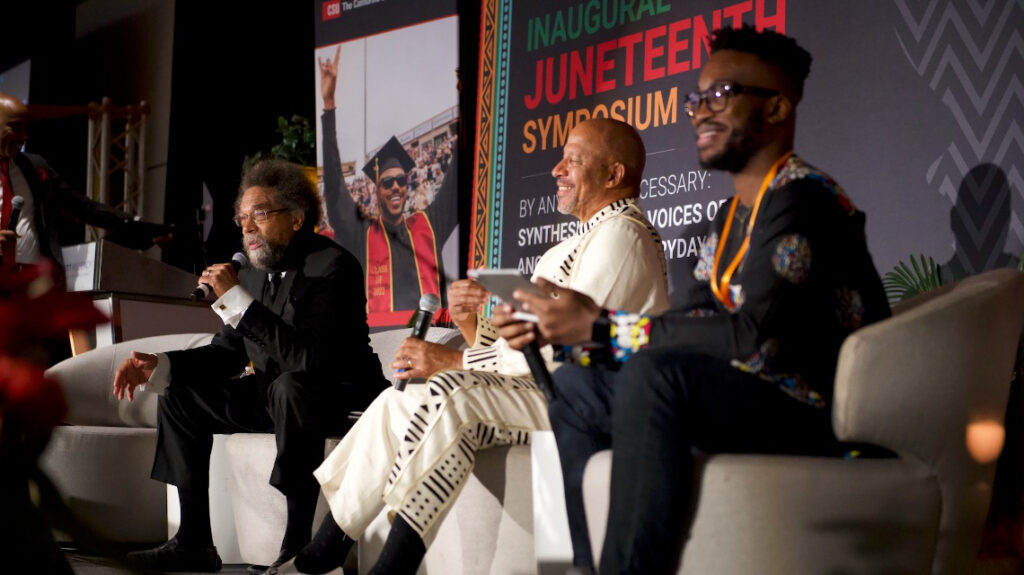
California State University (CSU) held its first Juneteenth Symposium June 15 and 16, celebrating Black history and achievement while demanding justice and equity within higher education and beyond. The event, hosted by CSUDH, was titled “By Any Means Necessary: Synthesizing the Voices of Our Ancestors and Everyday People.”
Recent San Diego State graduate and CSU Board of Trustees Emerita Maryana Khames led the push to create the symposium after listening to students demand action in the wake of George Floyd’s murder. Students called on the CSU to take the lead in combating anti-Black racism and champion diversity, equity, and inclusion across the CSU’s 23 campuses, and throughout higher education.
In acknowledging Khames, Board of Trustees Chair Lillian Kimbell committed the CSU system to that purpose. “This year’s symposium is indeed a trailhead, but one that will guide us toward tangible and lasting change,” she said. “It’s essential that beyond the two-day celebration, we commit to finding short-term and long-term solutions.”

As the host university, CSUDH was active in the symposium planning and had key roles throughout. Vice President of Student Affairs William Franklin served as the event co-chair and master of ceremonies. He noted that CSUDH, as the host campus, was uniquely poised to nurture constructive and critical discourse.
“The campus was birthed out of the Watts Rebellion,” Franklin said. “We wanted to use this event to hold ourselves and the CSU accountable to shift the paradigm and move to act.”
Throughout the symposium, CSUDH students and alumni took to the stage to deliver remarks. They were joined by CSU presidents and officials, higher education experts, and prominent Black leaders and scholars. CSUDH President Thomas Parham said he wanted people to not only be inspired, informed, and empowered by speakers, but to create “a catalyst for real and substantive change in the CSU system,” and to “chronicle the issues for the entire nation to listen and bear witness to.”
View photos from the event on SmugMug.
Several themes recurred throughout the symposium, including the celebration of Black excellence and the personal courage required to break through institutional barriers and pursue higher education. Speakers emphasized the necessity of having Black people represented at every level of education, industry, and government, and the importance of Black youth being able to see themselves reflected in role models around them–particularly in educational settings.
“The very systems we oversee, the school districts that we serve, are oftentimes the primary mechanisms that do harm to Black children,” said keynote speaker Tyrone Howard, Professor of Education in the School of Education & Information Studies at UCLA. “If our discomfort is what’s required to help our young people feel comfortable, that’s the price we have to pay.”
Many also expressed profound gratitude for previous generations of Black freedom fighters, artists, and thought leaders who paved the way for people of today, as well as the necessity for the work to continue.

“We have to understand that this is a generational struggle,” said CSUDH student Makonnen Tendaji. “We don’t organize, we don’t become educated so that we benefit ourselves. We build our schools and teach our children so that they can benefit from that knowledge.”
The symposium’s distinctiveness and sense of urgency were evident throughout the programming. Lori Gilbert, an attendee and staff member from CSU Stanislaus, said that for the first time, she “truly saw the CSU as a whole, as 23 universities all pulling in the same direction.”
“Not only were speakers profound and impactful,” she added, “but the event brought the entire system into greater focus for me.”
At the close of the event, Parham outlined three steps for the CSU to take in order to “confront the romantic illusion that Black equality in the CSU is a reality,” including: introducing a cultural audit; intentional community-building with campus affinity centers; and accountability for when diversity goals are missed.
“The CSU system has had its consciousness pricked,” Parham said. “It is presented with an opportunity to engage in more intentional and deliberate efforts to positively impact the lives of its Black students, staff, faculty, and senior executives.
“Time and measurable outcomes will tell if and how quickly the CSU system and its campuses can close the gap between the aspirational selves we desire to be, and the real selves that are challenged to be better in meaningful and consequential ways.”








